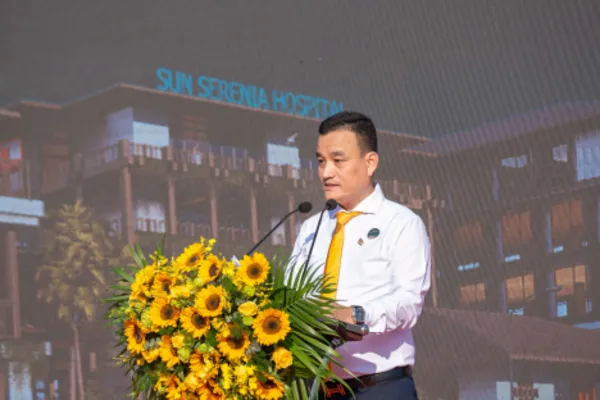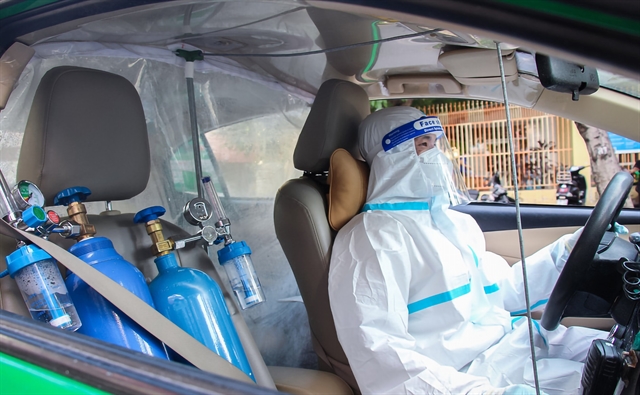 Society
Society

Emergency taxi teams now operate in many districts in the city. The taxi model has shown positive results since it was put into operation.

|
| Emergency taxi teams now operate in many districts in the city delivering supplies. Photo tuoitre.vn |
HCM CITY — Lê Tấn Sang, a third-year student of the University of Medicine Phạm Ngọc Thạch, wears his protective clothing and takes oxygen tanks and medical equipment in a car with his teammates to visit a coronavirus patient in HCM City’s District 4.
Sang set out on his mission after receiving a phone call from a female patient in Tôn Thất Thuyết Street.
The patient was a pregnant woman, who had tested positive for coronavirus and was self-monitoring her health at home.
The woman told Sang in a phone call that her son had a fever and cough. The boy had a history of pneumonia and needed help.
The team found the patient’s house after several phone calls. They then made a quick test for the child, which showed he was positive for SARS-CoV-2.
Sang and his teammates immediately decided to transport both the mother and the boy to Children's Hospital No 2.
Sang and his teammates breathed a sigh of relief after taking the patients to the hospital and seeing they did not show more severe developments.
Sang has voluntarily participated in the emergency taxi team, specialising in transporting coronavirus patients in HCM City’s District 4, since July 28.
Sang, head of the volunteer group, said that at the start the team had four members: a nurse, a driver and two students from his university.
An additional 10 students from his university have joined the team since August 5, with three students from other universities joining since August 11.
“All of us have the only one purpose – finding the fastest way to save COVID-19 patients from a critical situation,” Sang said.
Challenges
Sang said there were many difficulties and stresses doing the job.
“The hospitals are often overloaded while there are a lot of patients who need help,” he said. "Sometimes, I do not know which hospitals I can take them to."
“The biggest fear is that when the team takes a patient to a hospital, and the hospital informs us it has run out of oxygen to treat the patient."
When a patient is not accepted by a hospital due to overload, Sang and the team contact the city’s Health Department for further help.
In case of emergencies, such as a patient with cardiac arrest or sudden respiratory arrest, the team is forced to take them to the nearest hospital.
"Another difficulty is that District 4 has a lot of houses located in small, narrow alleys. It takes a lot of time and effort for the team to bring the patient out," he said.
Nguyễn Ngọc Minh, one of the female volunteers, often has to carry the oxygen tanks through the narrow alleys or bring patients down the stairs.
“It’s hard work,” Sang said. “However, all my fatigue disappears when I think I will save a life.”
Heartbreaking
On one occasion Sang and Minh went to a COVID-19 patient’s house and saw a man lying motionless. They measured the saturation of peripheral oxygen index of the patient and continued taking chest compressions, but it did not work. The man would not wake up.
“The patient passed away although we tried our best,” Sang said. "This is the first time I had seen a COVID-19 patient die at home.”
Minh was badly affected by the incident. “The fiercest, cruellest and the most tragic thing is seeing a patient slowly passing away but we can't do anything,” she said.
Operation
Emergency taxi teams now operate in many districts in the city.
District 4 is considered the most complicated place for the emergency taxi team because of its large number of COVID-19 cases.
Võ Hoàng Nhân, a representative of the city’s health department, said the taxi model had shown positive results since it was put into operation.
“It is believed to be the closest team to the patients,” he said. "There are now 65 taxis in operation under the model. The taxis operate 24 hours a day in every district to serve the demand of patients."
There is a plan to achieve a total of 200 taxis under the model by the end of this month,
HCM City has recorded thousands of additional cases of the virus every day. — VNS




